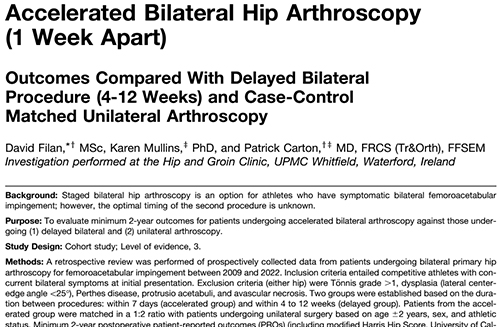Accelerated Bilateral Hip Arthroscopy (1 Week Apart): Outcomes Compared With Delayed Bilateral Procedure (4-12 Weeks) and Case-Control Matched Unilateral Arthroscopy
What is known about the subject: Athletes engaging in activities requiring higher demands from the hip have an increased risk of developing femoroacetabular impingement and becoming symptomatic. Current guidelines recommendations for a staged approach to bilateral hip arthroscopy is variable within the literature, where the timing of the contralateral hip surgery ranges from 2-weeks later to a minimum of 3-several months following the first hip. Available studies evaluating outcomes from patients undergoing bilateral hip arthroscopy largely represent a mix of patients presenting with bilateral symptoms as well as those who developed symptoms to the contralateral side at a later date. As such, the optimal timing for staged hip arthroscopy for the management of athletes who present with bilateral symptoms is unknown.
What this study adds to existing knowledge: An accelerated time between procedures (1-week apart) is a safe and effective strategy to improve symptoms and functional ability in athletes presenting with bilateral FAI symptoms and who meet the indications for arthroscopic surgical intervention. This study describes a novel time period for bilateral management in a selected group of patients treated in a highly specialised unit.








